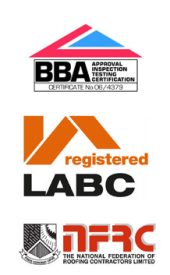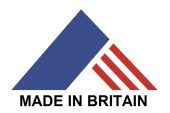All our standard TLX Gold solutions come with guaranteed U-value calculations and condensation risk analysis.
The temperature inside most houses is maintained at a comfortable level of around 20°C in living areas and 17°C in bedrooms. In the UK, the outside temperature is generally lower than this, especially in the winter. Heat flows from the warmer interior of the house, through the fabric of the building, to the outside. The U value expresses the rate at which heat is lost through a part of the house – such as roof, walls or windows. The U-value is expressed in units of Watts of power for every square metre of roof and for every degree temperature difference between the inside and the outside, or W/m2.K.
Part L1B 2010 requires a renovated roof to have a U-value of 0.18 W/m2.K. If the roof has an area of 70 square metres, and the temperatures inside and outside are 17 and 5°C, then the rate of heat loss through that roof is:
0.18 × 70 × (17 – 5) = 151 Watts
The U-Value of a roof is calculated by breaking the roof structure down into separate layers – such as plasterboard, insulation, rafters and underlay. The thermal resistance of each component is added together. Any materials of high thermal conductivity, such as timber rafters, form a cold bridge through the structure, and must be accounted for in the calculation, as must fixings and any poorly fitted insulation. The inverse of the total thermal resistance of the roof, plus allowance, gives the U-value for that roof structure. Examples of U-value calculations are shown in the TLX Gold solutions.
All TLX Gold U-Value calculations are carried out according to BS EN ISO 6946.
In general, the water vapour pressure inside the house is also greater than the vapour pressure outside. As well as heat trying to escape the building, so too water vapour tries to escape through the building fabric to the outside. The main mechanism by which water vapour is eliminated is through adequate ventilation. However, vapour will also try to diffuse through the walls and roof.
TLX Gold alters the temperature gradient across the insulation so that condensation is less likely to form in the air gap above the PIR or mineral wool, and ensures that even if condensation should occur then it is able to evaporate through the breathable TLX Gold.
More information can be found in our LABC Approved Solutions Guide.



© Copyright 2024. All Rights Reserved.
| Cookie | Duration | Description |
|---|---|---|
| cookielawinfo-checkbox-analytics | 11 months | This cookie is set by GDPR Cookie Consent plugin. The cookie is used to store the user consent for the cookies in the category "Analytics". |
| cookielawinfo-checkbox-functional | 11 months | The cookie is set by GDPR cookie consent to record the user consent for the cookies in the category "Functional". |
| cookielawinfo-checkbox-necessary | 11 months | This cookie is set by GDPR Cookie Consent plugin. The cookies is used to store the user consent for the cookies in the category "Necessary". |
| cookielawinfo-checkbox-others | 11 months | This cookie is set by GDPR Cookie Consent plugin. The cookie is used to store the user consent for the cookies in the category "Other. |
| cookielawinfo-checkbox-performance | 11 months | This cookie is set by GDPR Cookie Consent plugin. The cookie is used to store the user consent for the cookies in the category "Performance". |
| viewed_cookie_policy | 11 months | The cookie is set by the GDPR Cookie Consent plugin and is used to store whether or not user has consented to the use of cookies. It does not store any personal data. |
Error: Contact form not found.